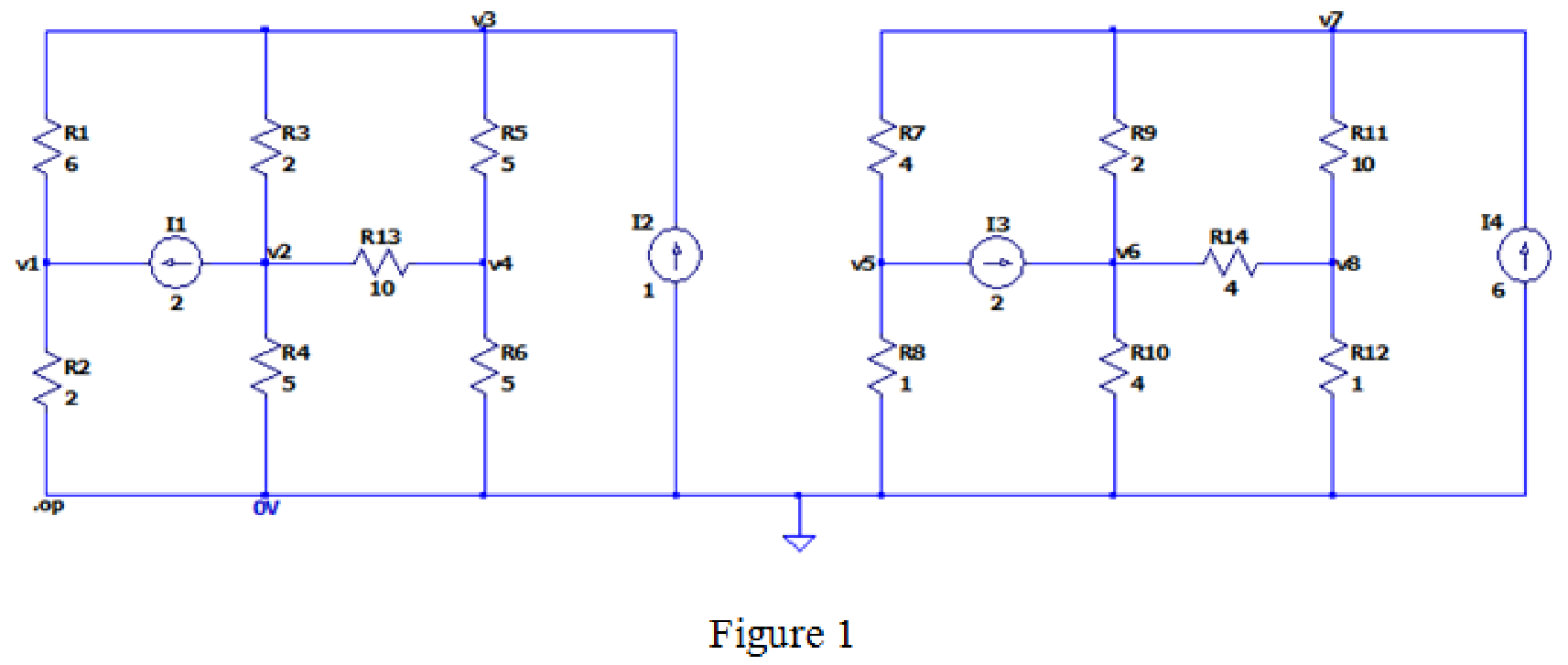
Verify numerical values for each nodal voltage in Exercise 14 by employing LTspice or a similar CAD tool. Submit a printout of an appropriately labeled schematic with the nodal voltages highlighted, along with your hand calculations.
Verify the solution obtained in Exercise 14 using LTspice.
Explanation of Solution
Calculation:
Refer to FIGURE 4.44 in the textbook.
Apply nodal analysis at node
Apply nodal analysis at node
Apply nodal analysis at node
Apply nodal analysis at node
Solve the equations by Cramer’s rule.
Find
Find
The value of
Find
The value of
Find
The value of
Find
The value of
Apply nodal analysis at node
Apply nodal analysis at node
Apply nodal analysis at node
Apply nodal analysis at node
Solve the equations by Cramer’s rule.
Find
Find
The value of
Find
The value of
Find
The value of
Find
The value of
Thus, the nodal voltages are,
| S. No | Node | Nodal voltage |
| 1 | 3.078 V | |
| 2 | –2.349 V | |
| 3 | 0.3109 V | |
| 4 | –0.3454 V | |
|
5 | 1.02 V | |
|
6 | 9.217 V | |
| 7 | 13.095 V | |
| 8 | 2.6768 V |
Draw the circuit diagram in LTspice as shown in Figure 1.

The output after simulating the LTspice circuit is,
--- Operating Point ---
V(v3): 0.310881 voltage
V(v1): 3.07772 voltage
V(v2): -2.34888 voltage
V(v4): -0.345423 voltage
V(v7): 13.0951 voltage
V(v5): 1.01901 voltage
V(v6): 9.21673 voltage
V(v8): 2.67681 voltage
I(I3): 2 device_current
I(I1): 2 device_current
I(I4): 6 device_current
I(I2): 1 device_current
I(R14): -1.63498 device_current
I(R13): 0.200345 device_current
I(R12): 2.67681 device_current
I(R11): 1.04183 device_current
I(R10): 2.30418 device_current
I(R9): 1.93916 device_current
I(R8): 1.01901 device_current
I(R7): 3.01901 device_current
I(R6): -0.0690846 device_current
I(R5): 0.131261 device_current
I(R4): -0.469775 device_current
I(R3): 1.32988 device_current
I(R2): 1.53886 device_current
I(R1): -0.46114 device_current
The both calculated and simulated values are approximately equal.
Conclusion:
Therefore, the solution is verified with the LTspice simulation.
Want to see more full solutions like this?
Chapter 4 Solutions
Loose Leaf for Engineering Circuit Analysis Format: Loose-leaf
- Present your complete analysis, solution in the proper sequence, and all needed figures. Show all computations.arrow_forwardDesign a 24v zener regulated power supply circuit that will power a 500 ohms load with 1A of of current. Determine the power rating of both bleeding resistor and load resistor. Note the computed power dissipation differ from the required power rating of the device.arrow_forwardI need help with this problem. Steps of what's being done would behelpful, please and thank you.arrow_forward
- 4a- Please solve all of these questions with all steps. Thanksarrow_forwardSUBJECT: Elements of Electrical Machines DesignINSTRUCTIONS: - Please write clearly and understandable way. - Write all the corresponding Given with their corresponding symbols and units. - Draw/Illustrate the diagram/circuit or drawings that is related to the problem, IF POSSIBLE, which is HIGHLY REQUIRED. - Solve in step-by-step, no shortcut - Underline twice the Final Answer.PROBLEM: How does the copper loss vary with the load in a transformer?arrow_forwardPlease solve with hundred percent efficiency Don't use solution which is already on site Write neat and clean by hand solution in the order to get positive feedbackarrow_forward
- Draw a series-parallel connection in DC using three lamps and two switches in the Schematic Diagram, Pictorial Diagram, and Single Line Diagram. Handwritten or digital style is acceptable. Thankyou!arrow_forwardshows a circuit containing a dependent voltage source and an independentcurrent source. Explain the steps that need to be taken to obtain the current passingthrough 1kΩ by applying the Mesh Analysis method.arrow_forwardThe system of using helicopters to work on live power lines is based on the principle that electrical current seeks to flow into the ground. Select one: True Falsearrow_forward
 Introductory Circuit Analysis (13th Edition)Electrical EngineeringISBN:9780133923605Author:Robert L. BoylestadPublisher:PEARSON
Introductory Circuit Analysis (13th Edition)Electrical EngineeringISBN:9780133923605Author:Robert L. BoylestadPublisher:PEARSON Delmar's Standard Textbook Of ElectricityElectrical EngineeringISBN:9781337900348Author:Stephen L. HermanPublisher:Cengage Learning
Delmar's Standard Textbook Of ElectricityElectrical EngineeringISBN:9781337900348Author:Stephen L. HermanPublisher:Cengage Learning Programmable Logic ControllersElectrical EngineeringISBN:9780073373843Author:Frank D. PetruzellaPublisher:McGraw-Hill Education
Programmable Logic ControllersElectrical EngineeringISBN:9780073373843Author:Frank D. PetruzellaPublisher:McGraw-Hill Education Fundamentals of Electric CircuitsElectrical EngineeringISBN:9780078028229Author:Charles K Alexander, Matthew SadikuPublisher:McGraw-Hill Education
Fundamentals of Electric CircuitsElectrical EngineeringISBN:9780078028229Author:Charles K Alexander, Matthew SadikuPublisher:McGraw-Hill Education Electric Circuits. (11th Edition)Electrical EngineeringISBN:9780134746968Author:James W. Nilsson, Susan RiedelPublisher:PEARSON
Electric Circuits. (11th Edition)Electrical EngineeringISBN:9780134746968Author:James W. Nilsson, Susan RiedelPublisher:PEARSON Engineering ElectromagneticsElectrical EngineeringISBN:9780078028151Author:Hayt, William H. (william Hart), Jr, BUCK, John A.Publisher:Mcgraw-hill Education,
Engineering ElectromagneticsElectrical EngineeringISBN:9780078028151Author:Hayt, William H. (william Hart), Jr, BUCK, John A.Publisher:Mcgraw-hill Education,





